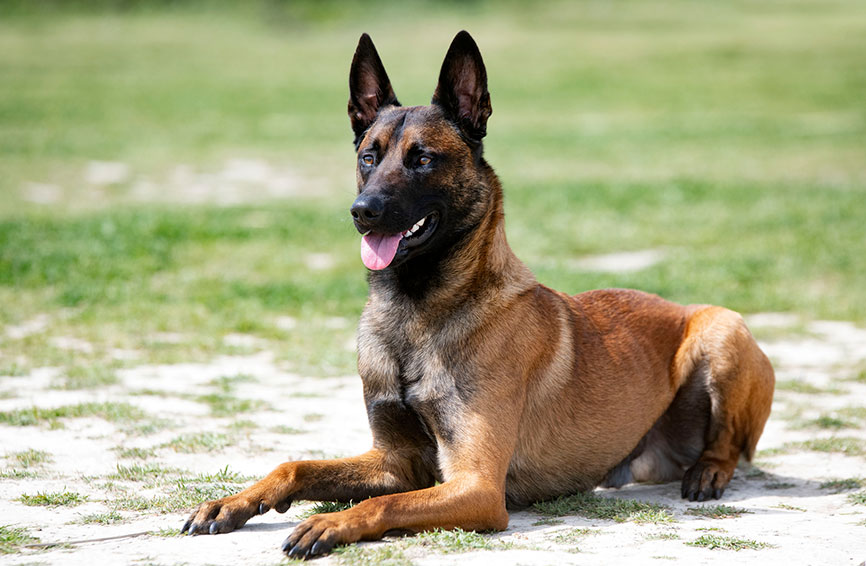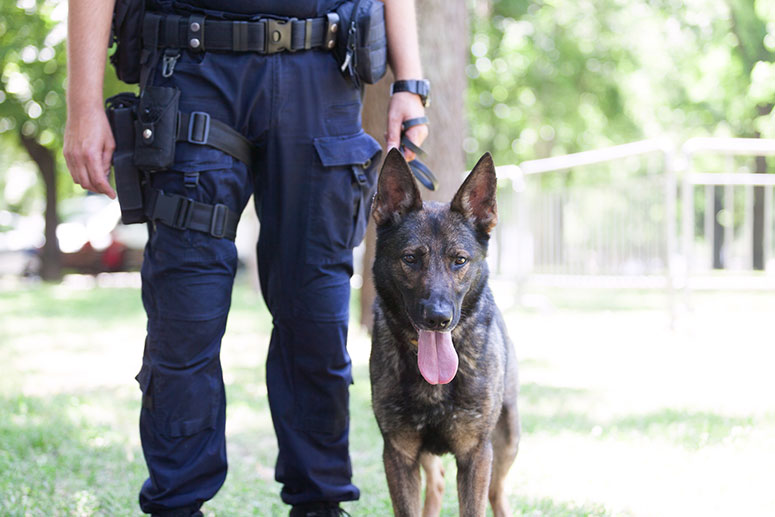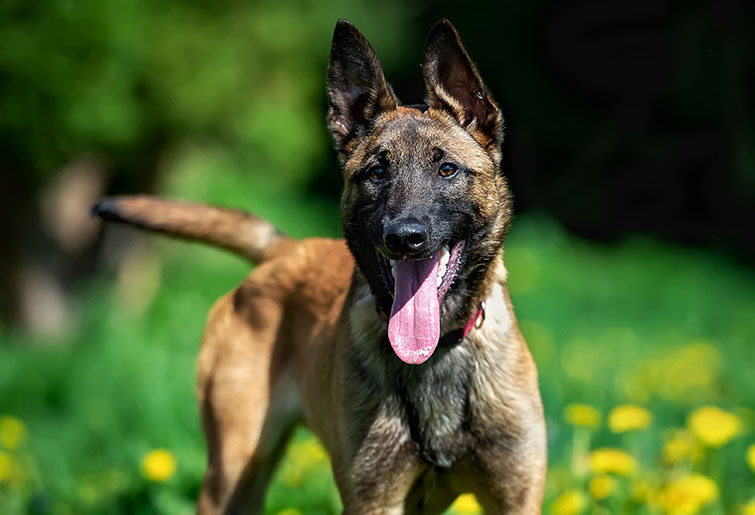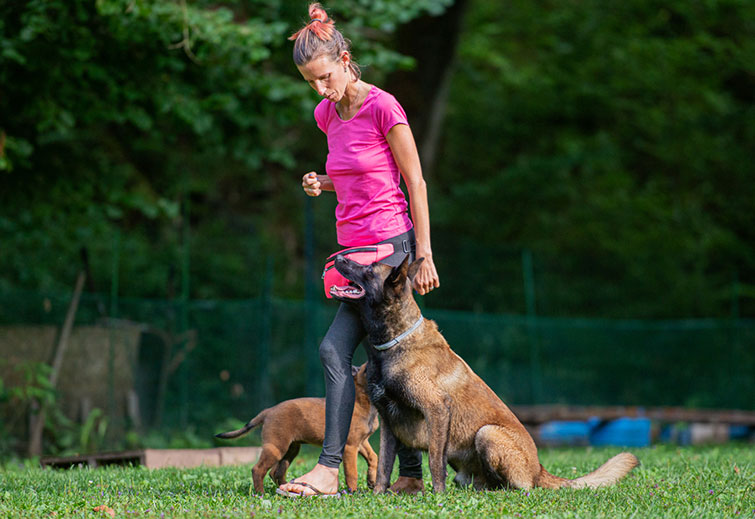Table of Contents
Introduction to Belgian Malinoises
As part of the herding group of dogs, the Belgian Malinois is an excellent worker that is smart and confident. It is a versatile dog breed that is easy to bond with and has an elegant appearance. But despite the dog’s hardworking nature, these are people-loving dogs that need a good amount of attention and exercise. They can excel at police and military work, but can also be just as happy with active families who are prepared to provide them with lots of physical and mental activity in exchange for lifelong loyalty.
Here is an overview of the Belgian Malinois so that you can decide whether this is the right dog breed for your personality and lifestyle.
Size of Belgian Malinoises
When fully grown, a male Belgian Malinois will weigh 60 to 80 pounds, while a female will be more like 40 to 60 pounds. Male Belgian Malinoises are 24 to 26 inches tall, and females are 22 to 24 inches tall. They are large dogs that usually stop gaining weight at about two years of age and stop getting taller around the age of 12 months.
Here’s how big you can expect your Belgian Malinoisto get as the dog grows during the first year. Female weights are on the low end of these ranges, while male weights are on the high end.
| Weight Chart | 3 months | 6 months | 9 months | 12 months |
| Male and female Belgian Malinoises | 11-29 lbs. | 28-59 lbs. | 37-71 lbs. | 40-75 lbs. |
Characteristics of Belgian Malinoises
A Belgian Malinois is intelligent and energetic with high exercise needs. These dogs need room to move around in and do not typically do well in small spaces, such as apartments, unless their owners are very committed to getting outside to exercise them. They are not the best breed for a first-time dog owner, but they are fairly adaptable to both hot and cold weather. Ultimately, they are high-energy dogs that need a lot of love and care, which you can help give them by enrolling in pet health insurance through Healthy Paws.
As you get to know a Belgian Malinois’s personality, here’s what you can expect based on his or her breed characteristics:
| Breed Characteristic | Level (High, Medium, Low) |
| Affectionate with People | Medium |
| Good with Kids | Medium |
| Good with Pets | Low |
| Need for Exercise | High |
| Energy Level | High |
| Intelligence Level | High |
| Able to Be Trained | High |
| Amount of Barking | High |
| Amount of Shedding | Medium |
Belgian Malinois Breed Standard Information
A breed standard is a description of an ideal dog of that breed that serves as a baseline for dogs to be judged at shows. The parent breed club of the Belgian Malinois established this standard, which is now accepted by national and international organizations. For example, the Belgian Malinois is well-balanced, square-shaped, elegant, agile, hardy, and full of life.
Here is an overview of the breed standard information for Belgian Malinoises:
Head:
- Carried high and long
- Medium size, slightly almond-shaped eyes
- Small and high-set ears
- Medium length muzzle
- Thin, tight, and black lips
- Scissors or level bite
Neck, Topline, Body:
- Slightly elongated and well-muscled neck
- Croup very slightly sloped
- Tail strong at the base and curved and raised when moving
Forequarters:
- Muscular without excessive bulkiness
- Dewclaws may be removed
- Cat-like, well-padded feet
Hindquarters:
- Powerful without heaviness
- Dewclaws may be removed
- Slightly oval hind feet with arched, compact toes
Coat:
- Short, straight, and hard, to be weather resistant
- Dense undercoat
- Hair longer around the neck to form a collarette
Color:
- Rich fawn to mahogany
- Black tips on hairs
- Mask and ears are black
- Tips of toes may be white
Gait:
- Smooth, free, and easy gait
- Fast gait
- A tendency to move in a circle rather than a straight line
Caring for Belgian Malinoises
A Belgian Malinois just wants a job and to be with family and not left alone outside or in a kennel. These dogs can do nearly anything, from military and police work to sledding, search and rescue, agility courses, and therapy work. They are obedient dogs with strong protective instincts. They’re also quick learners that love playtime and are best for pet parents who have some prior experience with dogs.
Here are some general tips for taking the best care of a Belgian Malinois:
Best Living Environments:
- Best in homes with older children rather than younger ones
- Houses with fenced yards
- Apartments okay if dogs receive enough exercise and mental stimulation
- Cool climates better than hot ones
Type of Exercise:
- Long walks on a leash
- Off-leash time in a fenced area
- About 20 minutes of activity three or four times per day
- Hiking and jogging with family members
- Running alongside a bike
Mental Enrichment:
- Playing fetch with a ball
- Obedience training
- Lots of play time with trusted people
- Organized activities such as agility or search and rescue training are ideal
Training Strategies:
- Very trainable dogs with firm and consistent patience
- Never use anger or force during training
- Train not to chase moving objects due to high prey drive
Grooming Tips:
- Minimal grooming needed
- Brush weekly with a firm bristle brush
- Bathe only when necessary
- Shedding is more prominent in the spring and fall
- Brush teeth daily
- Trim nails if not worn down naturally in the outdoors
Common Health Problems of Belgian Malinoises
The Belgian Malinois is a healthy breed of dog that typically lives for 14 to 16 years, which is quite long compared to other breeds of a similar size. However, even this healthy breed is still prone to certain genetic conditions, such as eye problems and hip and elbow dysplasia.
These are some of the most common health issues that arise with Belgian Malinoises:
- Progressive retinal atrophy
- Cataracts
- Hip dysplasia
- Elbow dysplasia
- Possible sensitivity to some types of anesthetics
Diet and Nutrition for Belgian Malinoises
Most adult dogs will thrive when eating a high-quality, nutritionally complete and balanced dog food. Belgian Malinois puppies should generally eat a large breed puppy food until they are around 12-18 months old. If you feed your Belgian Malinois homemade dog food, make sure you are working from a recipe that is designed by a veterinary nutritionist and is appropriate for your dog’s age and health status.
Feed the amount of dog food needed to keep your pet slim. You should be able to see your dog’s waist and feel (but not see) their ribs without having to press too hard. In general, puppies need more calories per day than adults, but a dog’s needs will vary with his or her activity level and other factors. Don’t leave food out all day for a Belgian Malinois to graze on. Divide the total amount of food for the day into at least two meals for adults and three meals for puppies. Place the food out in a bowl at approximately the same time in the morning and evening each day.
Some recommended brands of dog food for Belgian Malinoises are The Farmer’s Dog Fresh Dog Food, American Journey Active Life Formula Salmon, Brown Rice, and Vegetable, and Orijen Six Fish Grain-Free Dry Dog Food. Talk to your veterinarian if you have any questions about your dog’s diet or health.
Where to Adopt or Purchase Belgian Malinoises
The American Kennel Club Marketplace has a listing of AKC puppies from AKC litters and breeders who follow the rules and guidelines of this organization. The American Belgian Malinois Club is also a resource for both breeders and rescue organizations that focus on this type of dog. There are nonprofit organizations that help connect Belgian Malinoises to families as well, such as the Malinois and Dutch Shepherd Rescue, Woof Project, and Malinois Mountain Rescue.
Related Breeds
There are other dogs that resemble the Belgian Malinois in terms of physical appearance and personality characteristics. If you like everything that you have been reading about this dog breed so far, then you might also want to learn about these similar and related breeds before making your adoption or purchase decision:
- German shepherd
- Belgian sheepdog
- Belgian tervuren
- Belgian laekenois
Pet Insurance for Belgian Malinoises
Many Belgian Malinoises live long and healthy lives with few health problems or major accidents due to their good genetics. Yet emergencies can still happen when you least expect it if Belgian Malinois become too rambunctious, get into things they aren’t supposed to, or just get older and their bodies start wearing down.
One of the best things that you can do to take care of your Belgian Malinois is to sign your pup up for pet insurance with Healthy Paws. We offer a #1 customer-rated pet health insurance plan with hundreds of thousands of pets enrolled and flexible premium and deductible options. This is budget-friendly pet insurance that makes it easy to pay for the vet care that your Belgian Malinois needs without thinking twice about the cost.
For your Belgian Malinois pet insurance quote, visit our website today or reach out to us at 855-898-8991 with any questions you have.













